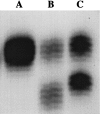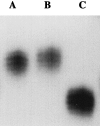Polymorphic variation at the BAT-25 and BAT-26 loci in individuals of African origin. Implications for microsatellite instability testing
- PMID: 10433928
- PMCID: PMC1866867
- DOI: 10.1016/S0002-9440(10)65131-0
Polymorphic variation at the BAT-25 and BAT-26 loci in individuals of African origin. Implications for microsatellite instability testing
Abstract
Instability in the repeat size of microsatellite sequences has been described in both hereditary nonpolyposis and sporadic colorectal cancers. Tumors expressing microsatellite instability are identified through the comparison of the repeat sizes at multiple microsatellite loci between tumor and matched normal tissue DNA. The use of a five-marker panel including two mononucleotide repeat microsatellites, BAT-25 and BAT-26, has recently been suggested for the clinical determination of tumor microsatellite instability. The BAT-25 and BAT-26 loci included in this panel have both demonstrated sensitivity to microsatellite instability and normal quasimonomorphic allelic patterns, which has simplified the distinction between normal and unstable alleles. However, in this study, we identified allelic variations in the size of the poly(A) tract at BAT-26 in 12.6% of 103 healthy African-Americans screened. In addition, 18.4% exhibited allelic size variations in the poly(T) tract at BAT-25. Finally, 2.9% showed variant alleles at both BAT-25 and BAT-26 loci. Screening a small population of Nigerians confirmed the polymorphic nature of both loci and the ethnic origin of alleles not identified in other populations studied thus far. Our results dispute the quasimonomorphic nature of both BAT-25 and BAT-26 in all populations and support the need for thorough population studies to define the different allelic profiles and frequencies at microsatellite loci.
Figures



References
-
- Thibodeau SN, Bren G, Schaid D: Microsatellite instability in cancer of the proximal colon. Science 1993, 260:816-819 - PubMed
-
- Aaltonen LA, Peltomaki P, Leach FS, Sistonen P, Pylkkanen L, Mecklin J-P, Jarvinen H, Powell SM, Jen J, Hamilton SR, Petersen GM, Kinzler KW, Vogelstein B, de la Chapelle A: Clues to the pathogenesis of familial colorectal cancer. Science 1993, 260:812-815 - PubMed
-
- Ionov Y, Peinado MA, Malkhosyan S, Shibata D, Perucho M: Ubiquitous somatic mutations in simple repeated sequences reveal a new mechanism for colonic carcinogenesis. Nature 1993, 363:558-561 - PubMed
-
- Kinzler KW, Vogelstein B: Lessons from hereditary colorectal cancer. Cell 1996, 87:159-170 - PubMed
-
- Fishel R, Wilson T: MutS homologs in mammalian cells. Curr Opin Genet Dev 1997, 7:105-113 - PubMed
Publication types
MeSH terms
Substances
Grants and funding
LinkOut - more resources
Full Text Sources
Other Literature Sources

